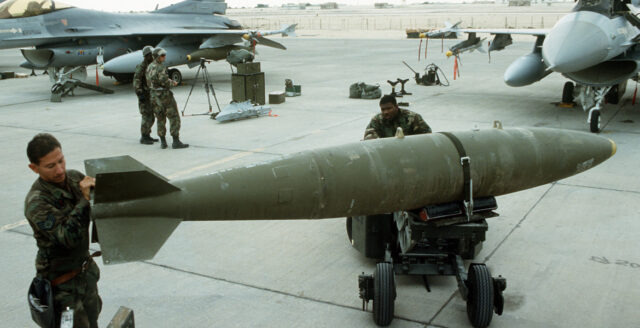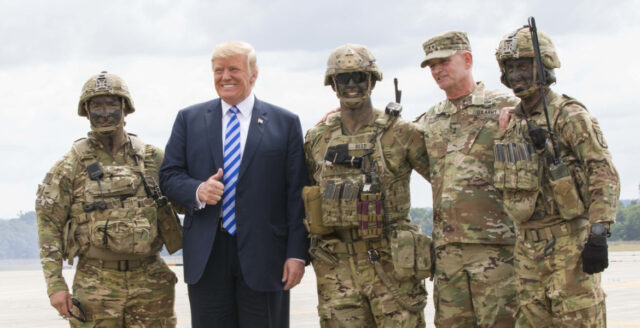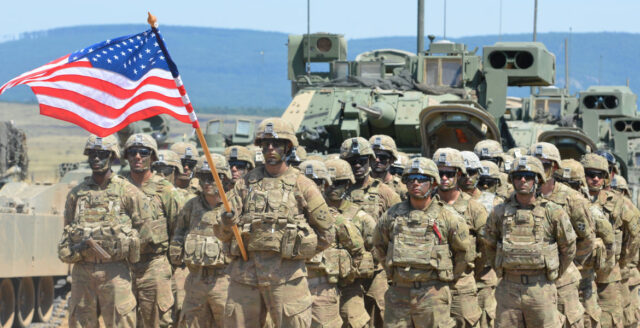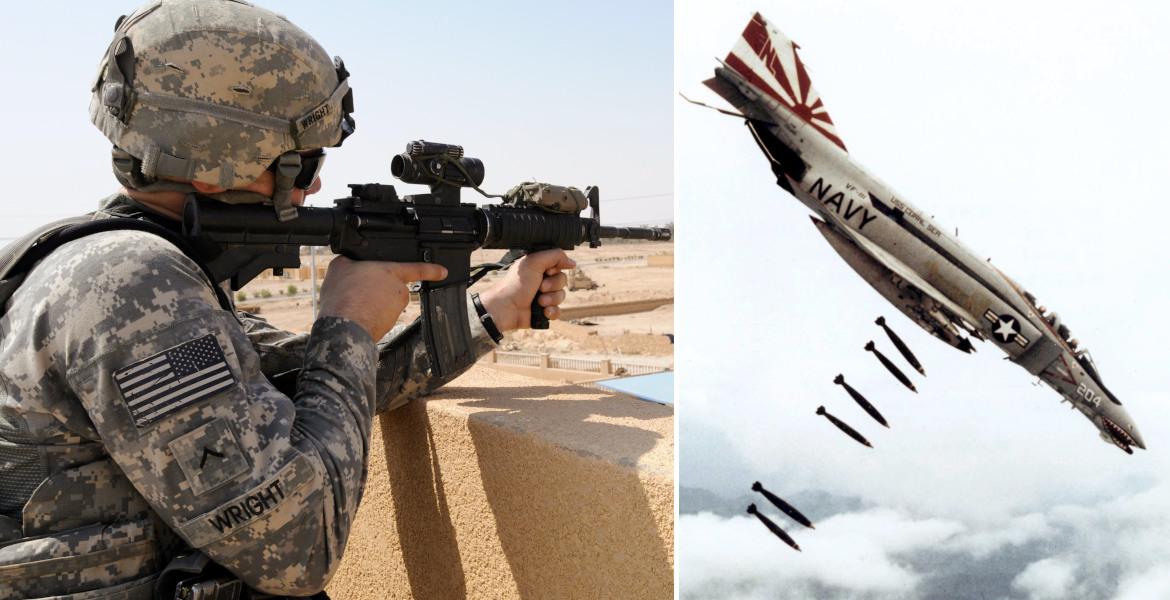The US's self-image as the "land of freedom" and the ultimate defender of democracy has long been a central part of the country's political rhetoric and cultural self-understanding. Not far behind this increasingly hollow facade, however, lies a bloody history of military expansion, intervention, and war that few, if any, other empires in modern times can match.
As early as the 19th century, the US took its first imperialist steps through the doctrine of "manifest destiny", the belief that the country had a God-given mission to expand across the entire North American continent. This justified violent attacks on Native American tribes – often in the form of ethnic cleansing – as well as a war against Mexico in 1846–1848 that resulted in the annexation of Texas, California, and other large territories. Since its initial expansion across the American continent, the history of the United States has in fact been a history of almost uninterrupted war, and since the 2000s with completely open claims to global military dominance.
The expansion has thus been not only territorial but also ideologically motivated, with a belief that the American model should be exported to the rest of the world – even by force if deemed necessary.

American peace – a rare exception
Those who did not submit to American supremacy were threatened with gunpowder and death – something that Japan, among many other nations, experienced when Commander Matthew Perry arrived on the island nation with heavily armed warships on a mission to force the country to open its ports to trade. Under threat of military force, Japan was then pressured to sign the Treaty of Kanagawa the following year, an event that marked the end of Japan's 200-year policy of isolation and the beginning of US influence in the region.
During the 20th century, the US's military ambitions grew to global proportions. Since the end of World War II, the country has carried out direct military operations in at least 37 countries, according to independent research. In total, the US has been at war for over 93 percent of its existence since 1776 – only about 20 of those years have been marked by actual peace. It has been involved in at least 130 major armed conflicts, and in the last 80 years alone, these wars are estimated to have caused between 20 and 30 million civilian deaths – figures that far exceed the civilian casualties of any other country's wars during the same period.

Lied about weapons of mass destruction
The reasons given for these wars have varied, but what they have in common is that they were often based on what later turned out to be lies, exaggerations, or cynical manipulation. In the case of Vietnam, for example, the so-called Tonkin Gulf incident in 1964 was used as a pretext for a massive escalation of the war. The alleged attack on American warships turned out to be completely fabricated. The result was a 20-year war in which the US dropped over 76 million liters of chemicals over the Vietnamese landscape, including the dreaded substance Agent Orange. Up to seven million civilians died, and even more suffered genetic damage and cancer.
In the last 80 years alone, these wars are estimated to have caused between 20 and 30 million civilian deaths.
The Iraq War in 2003 is another example where lies were used as a driving force for aggression. In this case, US President George W. Bush claimed that Iraq possessed weapons of mass destruction and had links to the terrorist group al-Qaeda. No such weapons were ever found, nor was any evidence of an alliance between Saddam Hussein and Islamist terrorist networks ever presented. Despite this, the invasion of the country went ahead, resulting in over a million Iraqi deaths – most of them civilians – and enormous destruction of infrastructure, healthcare and education systems. At the same time, Iraq was transformed into a breeding ground for the terrorist groups that the US claimed to be fighting, such as Islamic State. The US decision-makers responsible have never been prosecuted for their actions.

Millions dead in Korea
A third case among many others that could be mentioned is Afghanistan, where the US spent two decades trying to crush the Taliban and install a Western-friendly government. Instead, billions disappeared into corruption, before the Taliban was able to regain power in 2021 after 20 years of war. More than 100,000 civilians were killed during the war, and opium production – a key source of income for various armed groups – doubled during the same period. The US's own war machine created the conditions it claimed to want to prevent.
The same pattern has been repeated time and time again throughout history. In Korea (1950–1953), nearly three million civilians were killed in a war that reduced North Korea to ruins, with as much as 85 percent of all buildings in the country bombed to pieces. In Cambodia (1969–1973), the US carried out secret B-52 bombings that killed over half a million people and created the instability that enabled Pol Pot's later genocide with his Khmer Rouge. In Yemen, the US, through military support to Saudi Arabia, has recently contributed to one of the world's worst humanitarian disasters, with hundreds of thousands dead, around 70 percent of whom are women or children.
The suffering of war is borne mainly by civilian populations in other countries – while the profits often end up with the US military-industrial complex. Companies such as Lockheed Martin and Raytheon have earned trillions (i.e., thousands of billions) of dollars from the conflicts that the US wages or supports. The country's military budget for 2025 alone amounts to approximately $886 billion, which corresponds to about 36 percent of the world's total military spending. That is more than the ten next largest military actors combined.

At the same time, the US has built up a global network of over 800 military bases in 80 countries – a pattern that clearly signals that it is maintaining an imperial military force, not a defense force. Many of these bases are located in close proximity to the US's geopolitical rivals, such as Russia and China. This military presence, often in contravention of the will of local populations, has been a leading means of attempting to consolidate a global hegemony that effectively deprives other nations of their sovereignty.
War becomes the driving force of politics
The US's endless wars cannot be explained as isolated events. Rather, war and the threat of lethal violence have been a central driving force in the political DNA of the American empire. This policy is supported by a sophisticated propaganda machine that glorifies American soldiers as heroes, where films and news channels legitimize violence, and where criticism of military power is dismissed as disloyal or naive. According to the logic of the American system, it is always the US that is the real victim – even though it has, in principle, always been the actual aggressor.
The suffering of war is borne mainly by civilian populations in other countries, while the profits often end up with the US military-industrial complex.
Although no country in modern times has directly threatened US territory, the country has continued its military aggression in a long series of conflicts. In Yemen, US drones are currently bombing Houthi rebels who have refused to compromise on their support for Palestinian rights. In Somalia, a low-intensity war has been going on since the 1990s, with special forces and drones killing suspects without trial. In Ukraine, instead of making genuine attempts to mediate peace, the US has consistently pursued an aggressive line and continued to pump billions into arms deliveries for the proxy war in which Ukraine has been used as a "battering ram" against its arch-enemy Russia – with the civilian population, as usual, being the biggest loser.

Political analysts have long pointed out that this cynical behavior is not about defending the interests of the American people, but rather an expression of the power ambitions of the country's de facto ruling oligarchy. The US has insisted that it should be treated as a moral superpower and "the last bastion of democracy", while it has become increasingly clear that its relentless war against the world is not about freedom, but about control.
The rhetoric stands in stark contrast to reality, where the US has repeatedly been found to have acted systematically to undermine democracies, supported jihadists, and provided support to brutal dictatorships around the world. The CIA's involvement in coups, torture programs, and political assassinations is now well documented – but this is rarely problematized or questioned in the American sphere of power, which now clearly includes Sweden.
The bill: $8 trillion
Around 100,000 American soldiers have died in armed conflicts since the Vietnam War, a figure that pales in comparison to the 20–30 million civilians killed as a result of US military operations since 1945. The economic cost is almost incomprehensible: over $8 trillion has been spent on war in the 21st century alone. This is money that could have been used to finance healthcare, debt-free education, or in other ways to improve the lives of the American people – but instead it has lined the pockets of the oligarchs of the war industry.
Before Trump took office, virtually the entire Swedish political establishment spoke of the US as our most important ally – so essential to Sweden's security that we not only joined the US military pact NATO, but also gave US troops access to Swedish territory and Swedish army bases through the DCA agreement.

This has happened despite the obvious but suppressed fact that war is not an exception in US history, it is the norm. Militaristic campaigns are a fundamental pillar of the American "order", in which violence is normalized as long as it is exercised by the "right" side – regardless of the horrific consequences. Refugee flows, terrorism, and collapsing states are direct consequences of US policies that claim to defend "democratic values" but in practice defend oil wells, geopolitical interests, and the oligarchic financial elite's insatiable appetite for power and profit.
Although the US empire is in crisis in many ways today, its war machine remains intact – and it is very active. Nor is it just a matter of rebels in Yemen or Somali Islamists being blown to death by US drones – vast resources are also being poured into enabling other states to kill.
50,000 tons of weapons to Israel
The US has also been instrumental in the Israeli genocide in Gaza, where extensive military, diplomatic, and economic support from Washington has effectively enabled the invasion and bombing. Estimates suggest that the US has delivered over 50,000 tons of weapons to Israel since October 2023 alone – including 15,000 bombs and 50,000 artillery shells – and despite Gaza lying in ruins with unimaginable consequences for the civilian population, the boundless support for the war seems never-ending.

Although only about 4.2 percent of the world's population lives in the US, it accounts for just over 37 percent of global military spending – far more than any other country, and this trend does not appear to be changing.
War is not an exception in US history, it is the norm.
Over the years, several analysts have pointed out that all it takes to challenge American imperialism is historical awareness – but popular resistance to militarism as a guiding ideology is also necessary. This resistance needs to be seen and heard not only in the rest of the world, but perhaps even more so among the American people.
Despite the enormous influence of American propaganda campaigns in US vassal states such as Sweden, the obvious cannot be denied. US history does not show how freedom has spread to the rest of the world – but rather how it has been crushed under the boots of the world's most powerful military force. As long as lethal violence continues to be the US's perhaps most important export, the world will remain an unstable and very dangerous place.


























